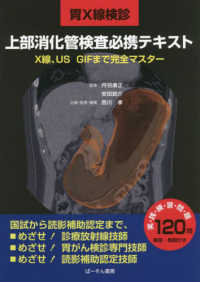- ホーム
- > 洋書
- > ドイツ書
- > Mathematics, Sciences & Technology
- > Biology
Full Description
These
Proceedings of the 2015 MICCAI Workshop "Computational Diffusion MRI" offer a
snapshot of the current state of the art on a broad range of topics within the
highly active and growing field of diffusion MRI. The topics vary from
fundamental theoretical work on mathematical modeling, to the development and
evaluation of robust algorithms, new computational methods applied to diffusion
magnetic resonance imaging data, and applications in neuroscientific studies
and clinical practice.
Over the
last decade interest in diffusion MRI has exploded. The technique provides
unique insights into the microstructure of living tissue and enables in-vivo
connectivity mapping of the brain. Computational techniques are key to the
continued success and development of diffusion MRI and to its widespread
transfer into clinical practice. New processing methods are essential for addressing
issues at each stage of the diffusion MRI pipeline: acquisition, reconstruction,
modeling and model fitting, image processing, fiber tracking, connectivity
mapping, visualization, group studies and inference.
This
volume, which includes both careful mathematical derivations and a wealth of
rich, full-color visualizations and biologically or clinically relevant
results, offers a valuable starting point for anyone interested in learning
about computational diffusion MRI and mathematical methods for mapping brain
connectivity, as well as new perspectives and insights on current research
challenges for those currently working in the field. It will be of interest to
researchers and practitioners in the fields of computer science, MR physics,
and applied mathematics.
Contents
An Efficient Finite
Element Solution of the Generalised Bloch-Torrey Equation for Arbitrary
Domains: L. Beltrachini et al.- Super-Resolution Reconstruction of
Diffusion-Weighted Images using 4D Low-Rank and Total Variation: Feng Shi et
al.- Holistic Image Reconstruction for Diffusion MRI: V. Golkov et al.- Alzheimer's
Disease Classification with Novel Microstructural Metrics from
Diffusion-Weighted MRI: T. M. Nir et al.- Brain Tissue Micro-Structure Imaging
from Diffusion MRI Using Least Squares Variable Separation: H. Farooq et al.-
Multi-Tensor MAPMRI: How to Estimate Microstructural Information from Crossing
Fibers: M. Zucchelli et al.- On the Use of Antipodal Optimal Dimensionality
Sampling Scheme on the Sphere for Recovering Intra-Voxel Fibre Structure in
Diffusion MRI: A.P. Bates et al.- Estimation of Fiber Orientations Using
Neighborhood Information: C. Ye et al.- A framework for creating population
specific multimodal brain atlas using clinical T1 and diffusion tensor images:
V. Gupta et al.- Alignment of Tractograms as Linear Assignment Problem: N. Sharmin.-
Accelerating Global Tractography Using Parallel Markov Chain Monte Carlo: H. Wu
et al.- Adaptive Enhancement in Diffusion MRI Through Propagator Sharpening: T.
Dela Haije et al.- Angular Resolution Enhancement of Diffusion MRI Data Using
Inter-Image Information Transfer: Geng Chen et al.- Crossing versus Fanning:
Model Comparison Using HCP Data: A. Ghosh et al.- White Matter Fiber Set
Simplification by Redundancy Reduction with Minimum Anatomical Information
Loss: G. Zimmerman Moreno et al.- A Temperature Phantom to Probe the Ensemble
Average Propagator Asymmetry: an In-Silico Study: M. Pizzolato et al.-
Registration Strategies for Whole-Body Diffusion-Weighted MRI Stitching: J.
Ceranka et al.- HARDI Feature Selection, Registration and Atlas Building for
A$\beta$ Pathology Classification: E. Schwab et al.- Reliability of Structural
Connectivity Examined with Four Different Diffusion Reconstruction Methods at
Two Different Spatial and Angular Resolutions: J. E. Villalon-Reina et al.






